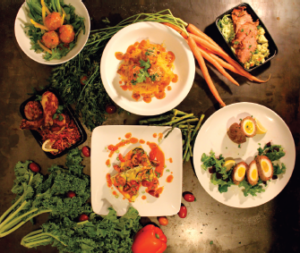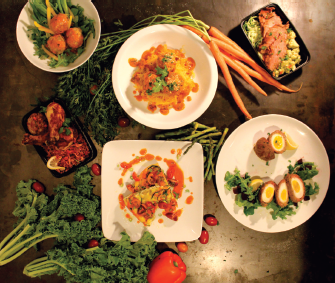Why the ‘Caveman Diet’ could be the future of food for the modern man.
By Alison Stoos


If you’ve already heard of the paleo diet, it can be easy to assume that its followers sit around eating turkey legs before and after squeezing in a life-draining CrossFit workout, as a large portion of the diet’s devotees are also high-intensity, heavy-lifting workout buffs. But there’s been a slight distortion of the diet’s real foundation by the media. Naomi Seifter, the owner of Picnik, Austin’s only paleo food truck, thinks the nickname Caveman Diet is misleading.
“I like the word ‘paleo’ in terms of paleolithic and paleolithic era, but I hate it being referred to as the Caveman Diet because we’re obviously not in caveman era,” she says.
Instead of focusing on gimmicky names to generate potentially fleeting interest, Seifter sees paleo in clear and honest terms.
“The principles that I consider to be paleo are that you eat a diet that’s rich in good-quality meat, wild-caught fish, fruit, vegetables and good-quality fat,” Seifter says.
Gerald Flynn, owner of Fixed Foods, Austin’s paleo subscription-based to-go food service, has a similar definition. He describes the diet’s foundations as “food that doesn’t have to be processed or preserved for us to eat and is nutritionally dense.”
In a nutshell, the paleo diet is simple. Seifter references Diane Sanfilippo’s best-selling cookbook, Practical Paleo, as “the bible of all things related to paleo.” In it, Sanfilippo explains the paleo diet, also referred to as a lifestyle, as “eating whole foods that provide better fuel for your body, and avoiding processed, refined, nutrientpoor factory foods.”
Within that, paleo excludes all grains, legumes (beans), white sugar, alcohol and dairy. That leaves meat, fish, fowl, vegetables, fruits and fat to enjoy. You might be asking yourself who would want to eat such a restrictive diet. Apparently, the answer is more and more people as paleo continues to rise in the healthy food scene. While a lot of people discover the diet and lifestyle out of a desire to either lose weight or improve exercise performance, both Seifter and Flynn found it out of necessity.
“We fell into it because my wife has an autoimmune disease, so we were trying to identify things to do to help cut down on her medication because the medication is extremely expensive,” Flynn says, noting that after trying a number of other diets, including pescatarian and vegan, his wife found paleo. “It eliminates, I would say, 95 percent of the potential triggers that cause inflammation in her disease.”
Seifter also experienced what she describes as a “slew of health issues” until she went completely grain-free close to four years ago. She remembers fighting with weight gain, stomach issues, acne, lethargy and hospitalization following a strict vegetarian diet when she lived in yoga ashrams studying the practice.
“I thought I was doing everything right. I was practicing yoga six to seven days a week, exercising. I was eating what I thought was a proper diet. At the same time, I didn’t feel good,” she says.
Finally, fed up with her health issues, Seifter began an elimination diet that eventually led her to paleo without her even knowing it.
“I didn’t know it was called [paleo]until I started getting online and looking for resources to figure out how to cook for myself because my food groups were so limited and I kept coming across the word,” Seifter says. “And a lot of people found it for the exact same reasons. Some people decided to try it as more of a short-term weight-loss plan, but for a lot of people, it was because they really are intolerant to so many of the things that are present in today’s food supply.”
Since committing 100 percent to a paleo lifestyle, Seifter has transformed both her body and her health, shedding excess pounds and ridding herself of all her chronic ailments. Although Seifter and Flynn’s wife aren’t alone in their health transformations, paleo still faces its fair share of backlash. Among its criticisms, some people believe the diet to be too expensive, too hard to maintain and solely reserved for the CrossFit community.
“If there’s anything that you would invest in, I feel like it should be your body,” Flynn says. “I agree that grass-fed meat is more expensive than bargain-basement beef that you can find at the corner market, but you’re paying for quality.”
Seifter agrees, adding that the diet teaches willpower as its biggest benefit.
“We’re challenging people to grow,” she says. “We’re saying this is going to be a little more difficult and it’s going to take a little more time and it’s going to be a little more expensive, but you’re going to experience wildly amazing benefits if you do it. You’re going to get to a place where you aren’t a slave anymore to food.”
As for fitness choices, Seifter’s yoga background proves that anyone can experience the benefits of the diet.
“I know a lot of people use paleo for performance enhancement. For people who are heavy lifters, it makes them more efficient when they exercise, but for me, it’s never been about that,” she says.
If you’re thinking about taking the primitive plunge, most everyone in the paleo community agrees that a 30-day commitment is the easiest way.
“It’s just a month,” Flynn says. ”You think a month is a really long time, but you’ve lived plenty of them your entire life.”
One of Seifter’s favorite paleo programs is Whole30, featured in the New York Times’ best-selling book by Dallas and Melissa Hartwig, It Starts With Food. The program has few rules other than to commit 30 days to a “squeaky-clean” paleo diet without any cheats of alcohol, sugar, non-paleo approved foods or even paleo treats. The focus is not necessarily on weight loss, as weighing yourself or taking any measurements during the 30-day period is prohibited, but to change both your relationship with food and your body for good.
As for a local option, Fixed Foods offers its own version of a month-long paleo commitment called the 30 Day Reset, and Picnik offers many Whole30-compliant entrées for those not wanting to cook at home, along with its best-selling butter coffee as an easy way to integrate more healthy fats, which help curb non-paleo cravings. As a core component of the paleo diet, its followers get to enjoy plenty of fat, as long as it’s from safe sources such as grass-fed meat, pasture-raised poultry, avocados, nuts and grass-fed ghee (butter that has been clarified to remove the milk solids).
Maybe the Caveman Diet isn’t the best term for the paleo way of life, but it certainly harkens back to a simpler way of thinking about what we consume. If anything, paleo has its roots in stripping away the excess from diets, streamlining our way of viewing food and removing the things that get in the way of reaching our health and dietary goals. If it stills sounds like another passing fad diet, Seifter has your answer.
“One of my favorite quotes is that if [paleo]is a fad diet, then it’s the oldest fad diet in existence,” she says.
Perhaps then, the paleolithic cavemen were really on to something, and we could try channeling our inner primal ancestor— at least for a month.





